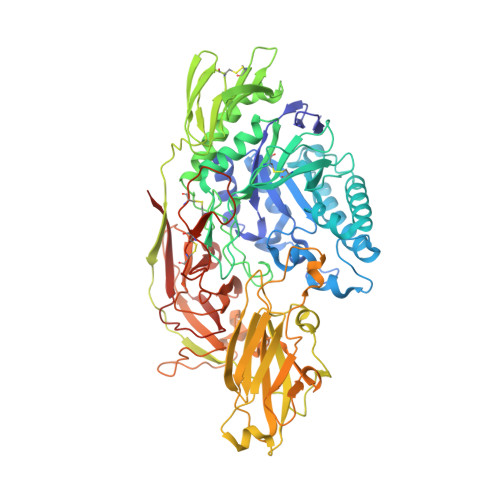Substrate-recognition mechanism of tomato beta-galactosidase 4 using X-ray crystallography and docking simulation.
Matsuyama, K., Kondo, T., Igarashi, K., Sakamoto, T., Ishimaru, M.(2020) Planta 252: 72-72
- PubMed: 33011862
- DOI: https://doi.org/10.1007/s00425-020-03481-4
- Primary Citation of Related Structures:
6IK5, 6IK6, 6IK7, 6IK8 - PubMed Abstract:
TBG4 recognize multiple linkage types substrates due to having a spatially wide subsite + 1. This feature allows the degradation of AGI, AGII, and AGP leading to the fruit ripening. β-galactosidase (EC 3. 2. 1. 23) catalyzes the hydrolysis of β-galactan and release of D-galactose. Tomato has at least 17 β-galactosidases (TBGs), of which, TBG 4 is responsible for fruit ripening. TBG4 hydrolyzes not only β-1,4-bound galactans, but also β-1,3- and β-1,6-galactans. In this study, we compared each enzyme-substrate complex using X-ray crystallography, ensemble refinement, and docking simulation to understand the broad substrate-specificity of TBG4. In subsite - 1, most interactions were conserved across each linkage type of galactobioses; however, some differences were seen in subsite + 1, owing to the huge volume of catalytic pocket. In addition to this, docking simulation indicated TBG4 to possibly have more positive subsites to recognize and hydrolyze longer galactans. Taken together, our results indicated that during tomato fruit ripening, TBG4 plays an important role by degrading arabinogalactan I (AGI), arabinogalactan II (AGII), and the carbohydrate moiety of arabinogalactan protein (AGP).
- Department of Biomaterial Sciences, Graduate School of Agricultural and Life Sciences, The University of Tokyo, 1-1-1 Bunkyo-ku, Tokyo, 113-8657, Japan.
Organizational Affiliation:




















